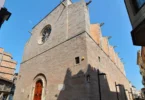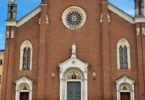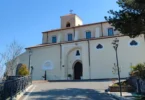
Introduction
Manapad is a coastal village 18 kms south of Tiruchendur, Thoothukudi District. St. Francis Xavier came to Manapad in 1542. Holy Cross Church built close to the sea in 1581, has a relic fragment believed to be from the True Cross of Jerusalem. From 1 to 14 September, every year, the cross is publicly displayed for thousands.
Manapad is rich in its culture and tradition handed down by their forefathers. The solemnity and splendor of the ceremonies practiced in Manapad are testimony to the cultural heritage the village has preserved till date.
Manapad was mostly inhabited by the Paravars who had embraced Christianity in 1532. However, for want of missionaries, the neophytes remained nominal Christians until the arrival and ministration of St. Francis Xavier in October 1542. Xavier chose a grotto which he preferred to use for a home.
Xavier used the Captain’s Cross which, with its raised platform and an overhead covering, worked as a built-in chapel, enabling him to offer daily services. St. Francis ministered the area until November 1543 when he returned to Goa. The next year, he was again at Manapad in March, June, August and September 1544 and went to Travancore in November.
Xavier was held in high regard by the people of Manapad for his austerity, moral strictness, compassion, and wise counsel. During his stay there, with the help of the pandits of Manapad, he translated the rudiments of the common prayers and trained the first catechists. These prayers are still being recited by the people in the area. While at Manapad, the saint had two youngsters, Augustine Paiva and Anthony Miranda, trained as acolytes. People in and around Manapad started venerating Xavier as a saint long before he was canonized by the Church.
The church of the Holy Cross was built in 1581, encasing the Captain’s Cross. Contributions towards building of the church were spontaneously given by the inhabitants and Rev. Fr. John de Salanova, the parish priest of the only church in the village (then dedicated to the “Queen of Heaven”), was able to complete construction long before the scheduled time.
History of the Holy Cross Shrine, Manapad
The feast of the Exaltation of the Holy Cross is celebrated annually by the Catholic Church on 14th September, as one of thanks giving for the recovery of the True Cross from the Persians by the great Emperor Heracuius. Fragments of the True Cross were in due course, brought from Jersusalem to many churches dedicated to the Holy Cross in the East and West.
These churches sought to imitate the solemn ceremonies in use at Jerusalem in order to do homage to the Holy Cross. Possibly one of the earliest dedications to the Cross in India was the Church of the Holy Cross in Manapad. Throughout the year many pilgrims visit the church and thousands congregate during the festive season from first to fourteenth September.
Traditional Origin Of The Church
Tradition has it that around 1540, a Portuguese trading vessel while sailing around the Cape of Good Hope, on its way to the East encountered a violent storm and had its sails split and the hind mast snapped. The vessel ran the risk of being foundered. The Captain who was devoted to the veneration of the Holy Cross, implored and entrusted the safety of the vessel and that of the acre to the crucified Christ. He also made a vow that he would construct a Cross from a portion of the splintered mast and has it implanted on the shore where they alight in safety.
Perchance, the vessel after having drifted for several days sought haven in then well known port of Kulesakharapatnam-Manapad. In fulfillment of his vow, the Captain had the Cross planted on the top of the hillock forming the natural Southern arm of the harbour. The Captain erected over the cross a small hut as protection against possible ravages of weather.
Revelation
The first miracle is said to have occurred when the cross was still in the nude form of a log cut off from the broken mast. It is said that when the log was laying on the shore an inhabitant of the village who had trampled on filth had cleansed his foot on this log. No sooner had he wiped his leg than he felt a pain and instantaneous swelling of the leg too. It was with the greatest difficulty that he was able to return home.
That night the man had vision in which it was revealed to him that the ailment was due to his defiling the log of wood intended for a sacred purpose, He was asked to wipe the much off the log, smear the log with oil and then apply the same oil to the affected foot to get cured.
Early next morning, the patient was carried to the spot where the log was and the amazement of the crowd that had collected there, there was immediate cure and the man was able to walk back home unaided. This remarkable happening made the occasion of the planting of the Cross by the Captain an event of great piety and festivity. From then onwards, the name and fame of the Captain’s cross spread throughout the Coromandel Coast.
Arrival Of St.Francis Xavier
Manapad was mostly inhabited by the Paravars who had embraced Christianity in 1532; but, for want of missionaries, the neophytes remained nominal Christians, until the arrival and ministration of St.Francis Xavier. The saint who arrived in Manapad in October 1542 found two spots which impelled him to choose Manapad as his favorite haunt during his sojourn in the Pearl Fishery Coast.
One was the presence of a grotto carved out of the rocky ledge, which he preferred to use as his abode. This cave was known in pre-Christian era as “Valli’s cave”, a counterpart of the one at Tiruchendur. It is now a signal grotto having at its outer entrance the stone tablet bearing the inscription: “This cave, the dwelling of a saivite sanyasi has been sanctified by the prayers and penance of St.Francis Xavier”.
The lonely hermitage with just the stars and the sea to keep company, chosen by Francis Xavier depicts his thirst for austerity and renunciation. Inspired by the Biblical exhortation, “What doth it profit a man, if he gain the whole world, and suffer the loss of his own soul?” he cast to the winds the professorship attached to the University of Paris and joined the Society of Jesus in answer to the clarion call of the Founder of the Society, St.Ignatius of Loyola.
No wonder then, that here joiced to take up abode in this cave. The other spot that induced him to choose Manapad with rapturous delight was the Captain’s Cross with its raised platform and an overhead covering, almost providing a built-in chapel enabling him to offer daily the Sacrifice of the Holy Mass. St.Francis Xavier toiled among the PARAVARS, instructing and ministering all along the Pearl Fishery Coast until November 1543 when he returned to Goa. He was again at Manapad in March, June, August and September 1544 and went to Travancore in November.
Relic of the True Cross
With the erection of the church, Rev. John de Salanova decided it should possess a relic of the True Cross. In 1583 he appealed to Rome through the General of the Jesuits Rev. Fr. Aquaviva for a fragment of the True Cross. Pope Gregory XIII obliged and the relic appears to have arrived at Cochin in the first week of August 1583.
Rev. Mathew de Medina of the Order of Christ, the prelate of Cochin, received the relic, after exposing it for three days for the veneration of the faithful, he inaugurated the grand tour of the relic all along the coastal belt with halts in places of Catholic predominance. The procession reached Manapad a few days before the festival of the Exaltation of the True Cross. Many Catholics followed in procession with the relic. In later years, Manapad came to be a traditional place of pilgrimage to those of the Malabar Coast.
Notable Religious Art
There has been much speculation about the crucifix that adorns the high altar of Holy Cross Church. The most popular belief is that the crucifix had come together with the well-known “Our Lady of Snows” statue in the Our Lady of Snows Basilica in Tuticorin. This assumption is untenable, because there was no church or priest in Manapad until sometime in the 1570s. However, both the crucifix and the “Our Lady of Snows” statue originate from Manila, with the crucifix sent at a later date.
The two afore mentioned items, as well as a statue of Child Jesus, were carried to Manila by Captain Ferdinand Magellan, a Spanish explorer who arrived in Cebu, Philippines, in March 1521. The first converts by Magellan were a chief named Humabon and his queen. The latter, baptized as Juana, was given the statue of Child Jesus, which came to be known as Santo Niño de Cebu, standing to this day above the high altar of the Basilica Minore del Santo Niño.
This statue for many millions of Catholic Filipinos is a national heritage. Magellan’s statue of Our Lady is a replica of the statue in the church of St. Mary of the Snows in Rome. It was gifted to Tuticorin by the Prioress of the convent in Manila in 1555. Subsequently, Fr. John de Salanova sought Magellan’s crucifix for his newly constructed church of the Holy Cross in Manapad. The Prioress was cooperative due to the rare papal conferment of the relic of the True Cross to Manapad. The exact date of the receipt of the crucifix is unknown.
Feast Day - 14th September
The festival of the Exaltation of the Holy Cross is celebrated annually by the Catholic Church on 14 September, as one of thanksgiving for the recovery of the True Cross from the Persians by the great Emperor Heraclius. Fragments of the True Cross were in due course brought from Jerusalem to many churches dedicated to the Holy Cross in the East and West.
These churches sought to imitate the solemn ceremonies in use at Jerusalem, in order to do homage to the Holy Cross. Possibly one of the earliest dedications to the Cross in India was the Church of the Holy Cross in Manapad. Throughout the year many pilgrims visit the church and thousands congregate during the festive season from 4 to 14 September, each year.
Mass Time
Weekdays
Saturday
Sunday
Mass for Children in the Church
Places to visit nearby
- Light House
- Tranquill Meditation Center
- Solitary Beach
- Wanderers Trail
- Manapad Point
- Melodic Sands Beach
- Blue Logoon
- Joseph’s Creek
- Palm Leaf Society
- Bird Watch
- Official Surfing Spot in India
Contact Info
Holy Cross Shrine,
Manapad, Tiruchendur – 628209,
Tuticorin District, Tamilnadu, India.
Phone No.
Tel: 04639 – 226224
Accommodations
How to Reach the Shrine
Holy Cross Shrine, Manapad, Tiruchendur, Tuticorin, Tamilnadu is well connected with Bus Station, Railway Station and Airport facilities rest of the country.
Manapad is a coastal village in far south India, 60 kilometres (37 miles) from Tuticorin and 18 km (11 miles) south of Tiruchendur, Tamilnadu, India.
Airways
Tuticorin Domestic Airport, Tamilnadu, Which is (55.9 Kms) from Holy Cross Shrine, Manapad, Tiruchendur, Tamilnadu, India.
Railways
The nearest railway station is Thiruchendur Railway Station which is just (18 Kms) from Holy Cross Shrine, Manapad, Tiruchendur, Tamilnadu, India.
Roadways
The nearest is Udankudi Bus Stand which is (8 Kms), Tiruchendur Bus Station which is (18 Kms) from Holy Cross Shrine, Manapad, Tiruchendur, Tamilnadu, India.







